Vessels - Middle East - Recent acquisitions - Sold antiquities
Archive of sold antiquities
All artefacts sold in our gallery are fully documented in our online archive and database. Being a specialist ancient art dealer, preserving also the more recent history of each and every piece sold in our shop is at our heart. That is particularly useful for artefacts that changed owners in the meantime. Information that may have been lost in the process can be easily restored from our archives. Please do not hesitate to contact us if you need further information about ancient items that have been sold in our gallery. We can help you with reconstructing the history of ownership for those items. All information about our customers will be kept confidential, of course.-
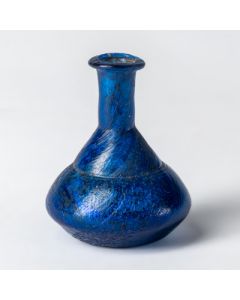 Roman ointment bottle of bright blue glass
Roman ointment bottle of bright blue glassA strikingly colourful bottle for oil or perfume. From the Roman Imperial period, made in a province of the eastern Mediterranean.
Price: on request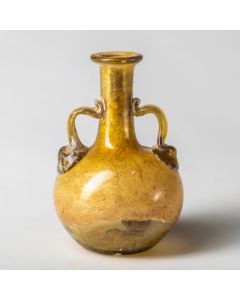 Roman glass bottle with handles
Roman glass bottle with handlesThe glass impresses with its elegant shape. Made in one of the Roman glass factories in the eastern Mediterranean during the Late Imperial period.
Price: on request Three ancient pottery vessels
Three ancient pottery vesselsAn exciting mixed group from the Iron Age to Classical Antiquity. From the collection of Professor Manegold.
Price: on request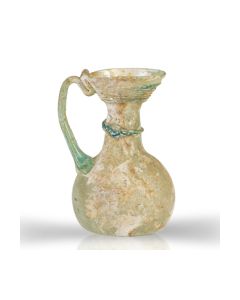 Roman glass pitcher
Roman glass pitcherFine and beautifully decorated glass pitcher from Roman Palestine, probably from an ancient workshop in what is now Jalamah. Around 500 AD.
Price: on request Roman globular glass bottle
Roman globular glass bottleBeautifully decorated with bands of incised decorative grooves. Spherical body and funnel-shaped neck.
Price: on request Two Roman glass unguentaria
Two Roman glass unguentariaThe early imperial perfume bottles are from the eastern Mediterranean. Acquired in 1974 from art dealer Albrecht Neuhaus.
Price: on request Roman ribbed glass bowl
Roman ribbed glass bowlOf beautiful, thick-walled glass of a bright light green color. The glass was mold made in a Roman factory of the eastern Mediterranean.
Price: on request Roman jug made of aubergine glass
Roman jug made of aubergine glassBeautiful glass with a violet colour. From the Roman Imperial period.
Price: on request Roman glass beaker
Roman glass beakerRare cup made of almost colourless glass. A 4th century product from the eastern Mediterranean.
Price: on request Roman glass bottle with handle
Roman glass bottle with handleThe cylindrical vessel has a nice iridescent patina. Made between 50 and 200 AD on the Black Sea coast or in the Near East.
Price: on request Late Roman glass flask
Late Roman glass flaskFlat bottle with double handle from the Eastern Mediterranean. Made between the 3rd and 6th century.
Price: on request Roman glass juglet
Roman glass jugletThe small jug with a pear-shaped body is outstanding due to the strongly iridescent patina and the dark coating on the outside. From the Late Roman Imperial period.
Price: on request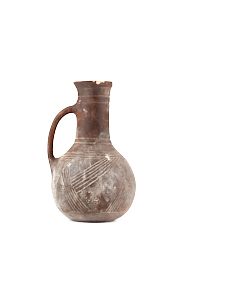 Anatolian clay jug with incised decoration
Anatolian clay jug with incised decorationThe Bronze Age vessel has wonderful linear decorative bands, the white filling of which contrasts with the dark slip. Circa 2500 to 2000 BC.
Price: on request Cypriot Lekythos with black slip
Cypriot Lekythos with black slipVery well preserved incl. original slip. From the collection of the German actress Lotti Huber, found during excavations in Cyprus in the 1950s.
Price: on request Driking cup of the Troy type
Driking cup of the Troy typeSo-called Depas Amphikypellon from around 2500 BC. The famous type of drinking vessel from Troy as described in Homer's Iliad.
Price: on request Persian bowl from Golestan
Persian bowl from GolestanNicely decorated with plant ornaments in black and turquoise. Made towards the end of the Islamic Golden Age in the Persian province of Golestan.
Price: on request Cypriot bichrome ware Lekythos
Cypriot bichrome ware LekythosVery well preserved incl. original painting. From the collection of the German actress Lotti Huber, found during excavations in Cyprus in the 1950s.
Price: on request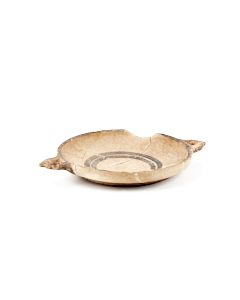 Cypriot bichrome ware dish
Cypriot bichrome ware dishLarge shallow dish painted with geometrical patterns in red and brown. Bichrome ware from the Cypro-Geometric period.
Price: on request Roman sprinkler
Roman sprinklerPerfume bottle with pattern-blown body. An aperture made it easy to dispense the precious content drop by drop. From the Late Roman period.
Price: on request Roman globular bottle
Roman globular bottlePerfectly preserved glass vessel with globular body. Made in the Eastern Mediterranean during late Roman Imperial times.
Price: on request Early Islamic glass with spiral thread
Early Islamic glass with spiral threadA marvelous example for Early Islamic glass after the conquest of the Levant, during Umayyad rule. A glass from the professor Ritschel collection.
Price: on request Cult vessel of the Yortan culture
Cult vessel of the Yortan cultureWonderful double vessel with incised decoration. From the Early Bronze Age of Western Anatolia.
Price: on request Sidonian perfume bottle
Sidonian perfume bottleGlass from Sidon with a decorative relief of amphorae and other vessels. A phoenician production from the 1st century AD.
Price: on request Roman cooking pot of the Herodian type
Roman cooking pot of the Herodian typeLarge vessel from Roman Imperial times. Most finds are known from the Roman province Iudaea.
Price: on request Juglet from Iron Age II
Juglet from Iron Age IIThis vessel from the Holy Land was made between construction and destruction of the First Temple in Jerusalem. From the well-known Dr. Steve Adler collection.
Price: on request Juglet from Iron Age II
Juglet from Iron Age IIThis vessel from the Holy Land was made between construction and destruction of the First Temple in Jerusalem. From the well-known Dr. Steve Adler collection.
Price: on request Painted Bronze Age cup
Painted Bronze Age cupThe well preserved Bronze Age pottery bears a geometric painted pattern. Acquired in 1977 at Davies Antiques in London, it is claimed to have been found in Syria.
Price: on request Hittite beak-spouted ewer
Hittite beak-spouted ewerImposing vessel with well preserved paint. It shows geometric figures and sun wheel. From the 2nd millenium BC.
Price: on request Roman glass beaker
Roman glass beakerThis beaker type was popular in the Holy Land during the time of Jesus Christ. But products of the local workshops were also exported.
Price: on request Bronze Age Elamite ceramic vessel
Bronze Age Elamite ceramic vesselBowl from the Middle Elamite period with painted geometric design. From the area of ancient Iran.
Price: on request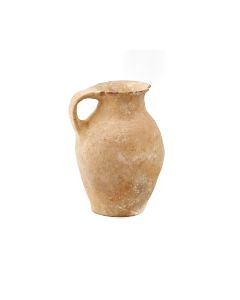 Iron Age jug
Iron Age jugMassive and imposing piece from the early 1st Millenium BC. Previously in the well-known Rihani family collection, with Jordanian export permit.
Price: on request Römische Keramikflasche aus Judäa
Römische Keramikflasche aus JudäaElegant geformtes Keramikfläschchen von der Levante. Beigefarbene Keramik. Frühe römische Kaiserzeit. Sehr gut erhalten.
Price: on request Eisenzeitlicher Keramikkrug von der Levante
Eisenzeitlicher Keramikkrug von der LevanteHervorragender Zustand. Bis auf minimalen Abrieb der Oberfläche perfekt erhalten. Ein Fund von der Levante, vermutlich aus Israel.
Price: on request Durchsichtiges römisches Unguentarium
Durchsichtiges römisches UnguentariumBirnenförmiger Körper, nach oben wieder breiter werdender Hals. Filigrab gearbeitetes, absolut durchsichtiges Glas. Höhe 5 cm, 1. - 3. Jh. n. Chr.
Price: on request Durchschimmerndes antikes Glasfläschchen
Durchschimmerndes antikes GlasfläschchenRömisches Glasfläschchen. Seltener Typ aus fast farblosem, durchschimmernden Glas. Levante, 1. bis 4. Jh. n.Chr.
Price: on request Kegelförmige Glasflasche
Kegelförmige GlasflascheAntikes römisches Glasfläschchen, Naher Osten. 90mm hoch. Vermutlich für Öl oder Parfüm verwendet. Kräftige Fundpatina.
Price: on request

